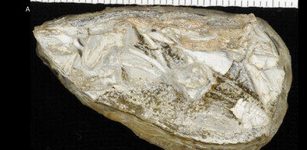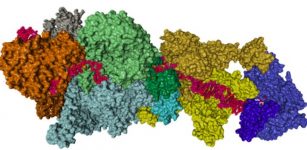T. rex’s Fancy Footwork Owed To Special Ligaments – New Study
Eddie Gonzales Jr. – MessageToEagle.com – New research by Holtz, Snively and co-authors tested the hypothesis that large ligaments strengthened the soles of tyrannosaurs’ feet near the toes in a way that would have been unique among large dinosaurs and not present in any modern animal.
Credit: University of Maryland
University of Calgary researcher Anthony Russell demonstrated for the study that the pull of ligaments and tendons can cause tyrannosaurs’ bones to extrude, leaving behind rough, undulating surfaces on the bone. Snively identified rough surfaces in tyrannosaur fossils, but it remained possible that unfossilized cartilage or quick growth might be responsible for the rugged terrain.
Lead author Lara Surring, of Alberta Health Services, realized that researchers could test for ligaments by training a scanning electron microscope (SEM) on the rough surfaces where bones touch in the tyrannosaur Gorgosaurus. The authors then extracted thin, translucent sections of metatarsal bones from a tyrannosaur and a “control” dinosaur, the small carnivore Coelophysis.
SEM revealed pits in the rough bone surface, which matches tight ligament attachments in modern animals. The internal bone structure of the tyrannosaur showed mineralized ligaments that anchored the sinews within the bone. Coelophysis lacked such strong attachments.
Researchers discovered even more ligament attachments that bound the foot together, both externally and internally. The authors’ methods also enabled them to rigorously test for the presence of soft tissues in fossil animals like tyrannosaurs. Soft tissues like ligaments and tendons are critical to how the skeleton functions, but they are rarely preserved in fossils. Finding evidence of these tissues helps elucidate how these ancient animals operated as living beings.
“With external and internal microscopy revealing its faded soft tissues, one small step for a tyrannosaur turns into a modest leap for understanding a vivid past,” Snively said.
Aside from answering a longstanding question, the intricacies of tyrannosaur feet also hold relevance for human health. People are among the best long-distance walkers and runners of any animal today, but ligament and tendon injuries are common, comprising an estimated 30-50% of sporting injuries.
Over-exertion can pull tendons and ligaments, so understanding how these structures attach to bone—even in extinct animals like dinosaurs—can help humans avoid such injuries.
“We are hopeful that learning how tyrannosaurs made skeletal adjustments to stay functional at the limits of animal size will eventually help us to evaluate and improve human skeletons after injury or aging,” Surring said. “This research is one more step in that direction.”
Written by Eddie Gonzales Jr. – MessageToEagle.com Staff











